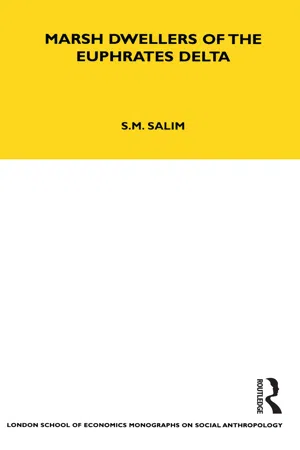
- 208 pages
- English
- ePUB (mobile friendly)
- Available on iOS & Android
Marsh Dwellers of the Euphrates Delta
About this book
Dr Salim, of Bagdad University, spent two years amongst the remarkable tribal peoples who inhabit the great marshes of the lower Euphrates. He describes their social and economic organization and discusses on the one hand the process by which people with bedouin traditions and values have adapted themselves to different and difficult conditions, and on the other the effects upon them of submission to the central government and the modernisation of their modes of life that has resulted from it. His account offers a fascinating study of people living in an unusual environment, and will be of value to the anthropologist and ethnologist for its precise ethnography. At the same time, as one of the few detailed studies of the changes now being wrought on such a large scale by modern economic and political forces, it has real importance for the general student of contemporary Middle Eastern affairs.
Frequently asked questions
- Essential is ideal for learners and professionals who enjoy exploring a wide range of subjects. Access the Essential Library with 800,000+ trusted titles and best-sellers across business, personal growth, and the humanities. Includes unlimited reading time and Standard Read Aloud voice.
- Complete: Perfect for advanced learners and researchers needing full, unrestricted access. Unlock 1.4M+ books across hundreds of subjects, including academic and specialized titles. The Complete Plan also includes advanced features like Premium Read Aloud and Research Assistant.
Please note we cannot support devices running on iOS 13 and Android 7 or earlier. Learn more about using the app.
Information
Plates
- 1. A. Four elders
- B. Lughmaija channel
- 2. A. A hut built on a reed platform
- B. A hut during the flood
- 3. A. A canoe shop
- B. A floating platform poled by two men
- 4. A. A floating platform with hut and buffaloes
- B. A youth milking a buffalo
- 5. A. A guest house
- B. A reed hut in an early stage of building
- 6. A. A man and boy cutting reed
- B. A family splitting and skinning reed
- 7. A. Mats stored ready for collection
- B. Fishermen's nets spread to dry in the sun
- 8. A. A dwelling island
- B. A large sailing boat with labour immigrants to Basra
MAPS AND DIAGRAMS
- Southern Iraq
- Ech-Chibayish village, distribution of clans
- Ech-Chibayish and Hor il-Hammar region
- Ahl Haji Sari lineage
Introduction
1
The Iraqi Marsh Dwellers

Table of contents
- Cover
- Half Title
- Series Page
- Title Page
- Copyright Page
- Foreword
- Acknowledgments
- Editorial Note
- Contents
- List of Plates, Maps and Diagrams
- Bibliography
- Index